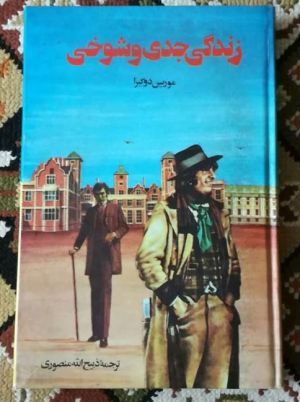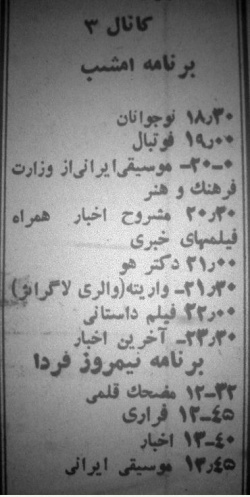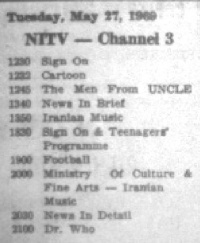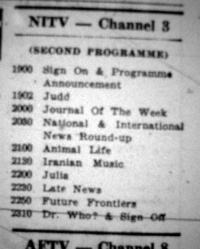Iran
IRAN is an Islamic Republic (formally known as Persia); it nestles between the Persian Gulf (Middle East) and the Asian continent.
Profile
| Country Number (28?) | 1968 | FIRST WAVE |
| Region | Middle East | |
| Television commenced | 1966 | |
| Colour System | 1973 | SECAM |
| Population | 1966 | 22.5 million |
| TV Sets | 1966 | 100,250 |
| Language/s | Farsi, Arabic and English | Dubbed |
Television Stations / Channels
Iran began its television service in 1966. To begin with, there was one commercial television broadcaster: Television of Iran, which operated channels 3 (also known as TV1) and 7 (TV2).
A second broadcaster was part of the Armed Forces Network, which was operated by the local US Air Force station; this was AFTV-Channel 8.
In May 1969, Television of Iran became National Iranian Radio & Television (NIRTV / NITV), operating channels 3, 7 and 9.
Doctor Who aired on Channel 3.
Colour transmissions began on NIRTV / NITV in 1973 using the SECAM colour broadcast system.
Language/s
The principal language of Iran is Farsi. English and Arabic are also recognised as a secondary language.
Doctor Who written in Persian, appears as (read from right to left):
دکتر هو
Farsi is similar to Arabic, and some programmes may have been broadcast in that language. English programmes were dubbed into Farsi. (It is a possibility that some programming, including Doctor Who, was simulcast in English.)
DOCTOR WHO IN IRAN
Iran was approximately the 28th country to screen Doctor Who. It was the fourth in the greater Middle East region (see Selling Doctor Who).
BBC Records
On 20 October 1967, the NZBC (New Zealand) sent episodes one and two of Marco Polo to Iran. These must have been supplied as "audition" prints (see Selling Doctor Who for more on these types of prints). Although Marco Polo was not included in the package of William Hartnell stories offered to non-English language countries (e.g. Arabic, Spanish), Iran must have considered Doctor Who a worthy purchase...
Iran is named in the list of 27 countries in The Making of Doctor Who (1972 Piccolo edition).
In a BBC sales catalogue from October 1968, it is noted that Iran bought "DR. WHO: Series B, K, R (19 progs)" [which are the three Dalek serials in the full package] and "DR. WHO: Arabic (37 progs)". It's clear from this that they acquired the standard package of pre-dubbed Arabic episodes that were circulated around North Africa and the Middle East (i.e. the package that included only the first episode of An Unearthly Child). However, that package already included the Dalek stories B and K which are also itemized separately.
But since R was not dubbed into Arabic, we might conclude that Iran purchased the standard 37-episode Arabic package plus another package that included B, K and R (at least) in a different format, such as in English or with Music / Effects tracks only. (Indeed, this would certainly explain why the sale of Doctor Who to Iran carries two invoice numbers for each serial: one for Arabic and the other for the alternative version.)
The series may have been broadcast in a variety of languages: Arabic for the first 37 episodes, Farsi for all 53 episodes, and English for all 53 episodes.
The Seventies records a sale of "(7)" stories by 28 February 1977. The Handbook identifies these as being: C, F, G, J, N, Q and R.
In DWM, Iran is identified in 8 story Archives: the same as above, plus L.
Although there are only eight stories recorded by these sources, Iran appears to have purchased (by July 1968) the standard package of twelve stories, 53 episodes that were supplied to non-English speaking countries (such as with Arabic and Spanish).
Stories bought and broadcast
WILLIAM HARTNELL
Twelve stories, 53 episodes:
| A | An Unearthly Child | 1 |
| B | The Daleks | 7 |
| C | Inside the Spaceship | 2 |
| E | The Keys of Marinus | 6 |
| F | The Aztecs | 4 |
| G | The Sensorites | 6 |
| J | Planet of Giants | 3 |
| K | The Dalek Invasion of Earth | 6 |
| L | The Rescue | 2 |
| N | The Web Planet | 6 |
| Q | The Space Museum | 4 |
| R | The Chase | 6 |
Iran therefore bought GROUP A, B, C, D and E (but minus the four historicals) of the standard non-English package of William Hartnell stories.
The programme was supplied as 16mm black and white film prints, some with existing Arabic sound tracks. Note: Although the official language of Iran is Farsi (also known as Persian), it is not too dissimilar to Arabic, so the episodes were probably broadcast as supplied.
What is not clear is whether NIRTV aired all four episodes of An Unearthly Child or only the first instalment as was the case in all the other Middle Eastern countries. If the complete 4-parter was not cleared for screening in "the Middle East", then that restriction would also apply to Iran. Certainly, the 1968 sales document noted above does not include parts two to four. On that basis, we feel sure that An Unearthly Child aired on its own.
As noted above, it's possible that Iran purchased two packages: the first being the 37 episodes dubbed into Arabic, the second being all 53 episodes in English. (NIRTV could have broadcast all three languages simultaneously; Arabic broadcast on television, with the original English and the Farsi dub (if there was one) broadcast over the radio. (The very fact that the TV listings appear in the English newspaper Kayhan indicates that some television programmes catered for non-Arabic / Farsi viewers.)
If this is the case, then this might explain the odd versions of The Web Planet part 1 and part 6 that exist, the first which is missing the recap lead in from the end of The Romans (which didn't screen in Iran), and the last which has a different "Next Episode" caption displaying "The Space Museum" rather than "The Lion" (which also didn't screen there). Iran is the only Middle Eastern country to screen season two stories beyond The Rescue, suggesting it was possibly the BBC's plan to try selling mixed language formats to other countries, with some episodes modified accordingly.
Origin of the Prints?
The Music / Effects tracks tapes for all the episodes would have been supplied by the BBC.
NIRTV aired the first seven serials in a split block between January and October 1969 -- the very same seven stories that had aired in Tunisia in 1967. It's therefore possible that Iran received the set of Arabic prints from Tunisia, plus a separate set of the five serials K to R from elsewhere.
The last three serials from season two were likely supplied directly from the BBC, especially if some of the episodes were indeed supplied by them in a slightly modified form.
Transmission
WILLIAM HARTNELL
The first clear listing on channel 3 for Doctor Who appears on Tuesday, 27 May 1969, commencing a run of 21 episodes that ended on 21 October 1969. (There was no episode on 5 August due to it being Constitutional Revolution Day.) The first six episodes aired at 9.00pm, with the remaining 15 episodes playing at the earlier time of 7.30pm.
Four months later, two additional listings appear, on Monday, 2 and 9 March 1970, at 7.30pm. However, the previous four weeks simply had "To Be Announced" listed in that half hour time slot, which might mean that six episodes of Doctor Who aired. (For many weeks prior to 2 February, that slot was occupied by a series billed as "Gaspar", which is probably a misspelling of "Casper", as in The Friendly Ghost.)
On Tuesday, 2 May 1970, the series returned, now at the much later time of 11.10pm. In fact, this was the last programme of the evening before "Sign Off". The slot changed to 11.20pm for the third episode before settling in at 10.50pm for the rest of the run of 18 episodes.
The 18th and last billing for "Dr Who? & Sign Off" appeared on 5 September 1970, with the same slot – through to 17 October - taken by a listing that simply said "FILM"; from 24 October the pre-Sign Off slot was filled by a news programme.
Allowing for the single pre-emption on 25 July (when the slot was filled by "All About Music"), with there being 18 episodes in this run, and with 21 in the 1969 run, that's 39 of the 53 episodes accounted for. Assuming that the two March 1970 episodes are the tail end of a longer run, and that the four "To Be Announced" billings are also for Doctor Who, those six bring the episode tally to 45, leaving eight unaccounted for. And that is also the episode count for the first two serials.
On that basis, we think the 27 May to 21 October 1969 run is Inside the Spaceship to Planet of Giants [*]; the six episodes in February / March 1970 is The Dalek Invasion of Earth (the reason for the four "To Be Announced" billings may have been down to uncertainty as to whether the Dalek story could be cleared in time for transmission); and the 2 May to 5 September 1970 run consists of The Rescue to The Chase, with the pre-empting "All About Music" neatly slotting in between The Space Museum and The Chase. This also means that The Chase part six is the last of the episodes billed as "Dr Who?" before the generic "FILM" listings kick-in the following week.
[* In the previous version of this profile, we had also surmised that this 21 episode run was Inside the Spaceship to Planet of Giants.]
This just leaves the first two serials / eight episodes unaccounted for.
BBC records indicate that the series was sold to Iran by 11 July 1968. During May through August 1968, there was a high number of consecutive weekly listings in The Kayhan that simply said "To Be Announced".
There were no TV listings at all in the December 1968 issues of The Kayhan. However, during January 1969, the 7.00pm slot on Wednesdays was listed as "To Be Announced" for five consecutive weeks, while the 1 January 1969 issue was missing, and the 12 and 19 February papers had no listings at all for channel 3. (From 26 February, the listings for channel 3 reappeared, but they did not have a listing for Doctor Who.) This gives us a perfect eight week window.
Based on the fact that there is a run of 12 weeks without a clear indication as to what aired on Wednesdays at 7.00pm, the "missing" eight episodes of Doctor Who could quite easily have aired at this time. The Airdates table has been noted accordingly.
There is no record that Iran screened Doctor Who again, even after the switch to colour in 1973.
Fate of the Prints?
In 1984, when Ian Levine spent hours telephoning or writing to foreign television stations in the search for missing episodes, he contacted an Iranian TV station asking if they still had any episodes of Doctor Who; the reply he got back was: "In the name of Allah, what are you talking about?"
With there being more than one TV station in Iran at the time, from that response, it would appear that Levine may have contacted the wrong one!
If, as we've noted above, the edited episodes of The Web Planet 1 and 6 that exist today are from NIRTV, then the station would have returned its prints to the BBC.
Indeed, in late 1976 when Whose Doctor Who was in production, the BBC held a complete set of 40 Arabic prints, plus prints of The Web Planet, The Space Museum and The Chase. Did these all come from Iran? (Since the edited print of The Web Planet part 6 was readily available within the bootleg video networks in the 1980s more so than the unedited version, it's very likely that the edited copy was the one held in 1976.)
Items of Interest
A book was published by Yadegar Publications in Iran in 1943, under the Persian title زندگی شوخی و جدی -- which best translates into English as "A Serious Life with Jokes" or "A Serious and Funny Life".
Credited to the prolific French author Maurice Dekobra (1885-1973), this tome was translated into Persian by Zabihullah Mansouri.
As far as we can tell, this appears to be a collection of French short stories by different writers, and Dekobra was merely the editor.
Dekobra wrote and collaborated on many books during his long career, but it's not readily clear exactly which of these this is, as the Persian title does not bear a direct translation to any of his known French works.
But the reason for including this here, is that the book cover of the 1983 edition (and subsequent reprintings) takes a painting of Tom Baker that originally appeared on the back cover of the 1978 Doctor Who Annual!
TV listings
| ← AIRDATES ...... (CLICK ICON TO GO TO TABLE SHOWING EPISODE BREAKDOWN AND AIRDATES - N/S = story title is Not Stated) |
Farsi listings are from the Persian / Iranian newspaper, Ittila'at.
English TV listings are from the English-language Iranian newspapers The Kayhan (International Edition) and Tehran Journal.
The Kayhan gave the title as "Dr Who", then "Dr Who?", complete with question mark. Most of the Journal's listings for the Doctor Who timeslot say "FILM". None of the listings gave episode titles.
Iran / Persia in Doctor Who
- Barbara says she feels like "Scheherezade", the teller of the Arabian Nights (The Crusade).








